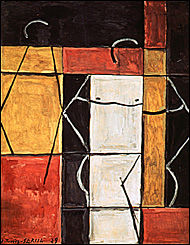
UNIVERSAL CONSTRUCTIVISM
![]() fter a long career in Europe, the Uruguayan artist Joaquín Torres-García returned to Uruguay in 1934 to create his “School of the South.” In a well-known drawing made after his return, he inverted the map of South America and stated, “Nuestro norte es nuestro sur” (“Our north is our south”) as a means to affirm South America’s independent role in modern art.
fter a long career in Europe, the Uruguayan artist Joaquín Torres-García returned to Uruguay in 1934 to create his “School of the South.” In a well-known drawing made after his return, he inverted the map of South America and stated, “Nuestro norte es nuestro sur” (“Our north is our south”) as a means to affirm South America’s independent role in modern art.
Torres-García elaborated aspects of European modernist movements with his own theories to create universal constructivism. Universal constructivism was a unique synthesis of indigenous traditions and modernism. It combined abstract geometry with intuition and emotion. Torres-García believed that the art of ancient civilizations worldwide reflected a unity of ethics, religion, and aesthetics. He believed that Latin American artists, drawing inspiration from ancient art traditions, could lead the way to a new art and society based on universal principles.
The work of Torres-García and his students is characterized by grids filled with symbolic shapes that serve as metaphors for greater truths. Perspective is flattened to emphasize essence over mere representation. Pure primary colors or soft earth tones predominate. Universal constructivist artists practiced and integrated all the visual arts: painting, sculpture, architecture, and crafts.
Torres-García’s concept of universal constructivism left an important legacy for Latin America. His art and theories affirmed Latin American identity and destiny but charted a different course from the
social realism advocated by the
Mexican muralists. Torres-García favored an abstract art rooted in Latin American experience that transcended local traditions to embrace universal values.
Movement
“The Indian”